Ijraset Journal For Research in Applied Science and Engineering Technology
- Home / Ijraset
- On This Page
- Abstract
- Introduction
- Conclusion
- References
- Copyright
Progressive Collapse Assessment of High-Rise Framed Structure Using ETABS Software
Authors: Sonu Kumar, Dr. Gunjan Shrivastava
DOI Link: https://doi.org/10.22214/ijraset.2023.54863
Certificate: View Certificate
Abstract
The structures generally get collapse due to the failure of one or a few structural components which then progresses over the successive of other components. This process is referred as progressive collapse of the structure. Local damage that initiates progressive collapse is called initiating damage. In order to study the collapse in analytical way, loading pattern or boundary conditions are required to be changed so that other structural elements within the structure are loaded beyond their capacity. This leads to development of alternative load paths to initiate the redistribution of loads. A typical model of a 12-storey structure is made on ETABS Software and analysis of reinforced concrete framed structure under critical column removal has been carried using the linear static analysis methods as per the guidelines provided in GSA (2003) and FEMA: 356 guidelines respectively taking into consideration the provisions of IS 1893:2002 codes to simulate dynamic collapse problems. Progressive collapse assessment is performed using cases of the inner Column removal due to LPG cylinder explosion. The results are then compared for the parameters such as Demand capacity ratio PMM ratio and Robustness indicator were checked for the acceptance criteria provided in GSA 2003.Based on results and comparing DCR values of different beams and columns with acceptance criteria given in GSA 2013 and American Society of Civil Engineering (ASCE) 41 [10], the conclusion can be made.
Introduction
I. INTRODUCTION
The R.C.C. building is consisting of elements such as column, beams, Slab, Foundation etc. these elements are also referred as load bearing elements of the structure. Though there are mainly two types of loads that acts on structure and are dead (DL) and live (LL) loads. The dead burden comprises of the heaviness of perpetual structure components, for example, segment; pillar though the live burden comprises of weight of moving individuals, furniture and so forth and the breeze load and seismic burden likewise follow up on the structure. At the point when the inside burden bearing basic component flops because of any number of means, for example, impact action or vehicular mishap which brings about the disappointment of a structure or segment to keep up its auxiliary uprightness this marvel is called breakdown wonders. This circumstance might be started by a tremor, inside or outside blasts and development exercises.
The grouping of the reasons for the structure breakdown is indicated under general headings given beneath:
- Faulty Construction
- Unexpected Failure Modes
- Extraordinary Loads
- Foundation Failure
- Column and beam failure
The overall issue of guaranteeing the security of structures of elevated structures against dynamic breakdown because of fire and impacts is turning out to be progressively pressing since, prompts intense outcomes. Mileage of fixed resources of the nation, expanding the rate and thickness of development in urban regions, an expansion as of late, the quantity of fear monger acts (bombings, fire related crime, and so on.) This makes the potential estimation of dynamic breakdown. The term “Progressive Collapse” can be simply defined as the ultimate failure or proportionately large failure of a portion of a structure due to the spread of a local failure from element to element throughout the structure.

II. OBJECTIVE OF PRESENT WORK
The main objective of this work is to do the Progressive Collapse Assessment of an asymmetric G+12 LODGE BUILDING situated in zone II of India. The same structure is modeled and analyzed by ETABS software.
Following are the objectives of this work-
- To identify the critical columns for the progressive collapse analysis of a multi-storey building.
- To determine the DCR (demand capacity ratio) for beams neighbouring to removed columns in both shear and flexure criteria.
- To determine the PMM Value (Column forces) for columns neighbouring to removed columns and determine the percentage increment in the forces as compared to the intact conditions.
- To plot the maximum displacement curve for all the structures.
III. LITERATURE REVIEW
Abhimanyu Abitkar (2013) did the Sustainable Analysis Procedures for appraisal of Progressive Collapse in 2011 utilizing SAP2000 for nonlinear powerful investigation and presumed that weighty punishment as far as increment in load factor is emerged in straight Static and Nonlinear static techniques and it is conceivable to locate the specific stacking that can give right conduct. The applied stacking in these techniques is very not as much as that of in genuine examination and plan. It is imperative to think about the nonlinear impact of floor piece in the investigation.
Alireza Kazem (2012) The impact of abnormality in stature of RC Structures on the Progressive Collapse through 3 RC structures of 6 stories each planned by Iranian solid code (ABA) and have been checked by ACI. They presumed that, the structures having unsure and pliancy has greater capacity in vitality ingestion and results in less harm. It implies that structure is safer.
H. Kazem (2021) studied have concentrated in 2018.that the dynamic breakdown appraisal of RC structures under quick and steady evacuation of sections. They reason that the Dynamic enhancement impacts brought about by quick expulsion of the segment lead to more appeal of pressure and distortion in the structure contrasted with continuous evacuation of the segment. It was additionally included that Plastic twisting in the neighbouring light emissions eliminated section in steady expulsion is 70 to 73 percent of the plastic misshaping in the prompt evacuation
Mohamadreza Rohani (2017) That a rearranged examination strategy to calculate the segment eliminated point removal at progressive breakdown investigation of strengthened solid structures. For dynamic breakdown examination of structures, direct static investigation, nonlinear static investigation, straight powerful examination and nonlinear unique investigation can be performed. At last, the impacts of the range's length, segments measurements, material properties and the bars fortifications of section eliminated ranges on base conduct is examined, too.
Preeti K. Morey (2012) That the progressive collapse of building are analyses using STADD Pro. Software. The two diverse investigation methods for surveying their adequacy in displaying dynamic breakdown situations; direct static and straight unique techniques. Investigation is done for (G+4) RC earth shake safe structures for various examination strategies to look at DCR values.
Raghavendra C. (2021) The "dynamic breakdown investigation of fortified cement confined structure". They examination a commonplace casing of stature 37.5m by direct static investigation system by the assistance of ETABS v9.7 programming. For RC outline investigation the sections at eight diverse area is taken out for each case. RC outline in the quake zones 2, 3, 4 and 5 is planned utilizing ETABS program for dead, live, wind and seismic burdens. The predetermined GSA load blend was applied and the DCR (Demand Capacity Ratio) esteem is determined for the structure individuals. They finished up the crossing light emissions length takes the over trouble load while eliminating the basic sections and the interest limit proportion estimations of that pillars were more contrasted with longer range. The sufficient support is given to dodge the dynamic disappointment.
Shaikh (2016) Dynamic breakdown of RC structs urea as per the rules gave in GSA: 2003 utilizing a Finite Element Method based programming ETABS. They have led the investigation on a RCC structure in which the sections at basic areas were eliminated to investigate the significance of piece's profundity in opposition of the dynamic breakdown and closed as: The Structure will turn out to be more basic when the inside Column at ground Floor is taken out, Since the pivotal obstruction limit increments with thickness of the section expands, the chunks having more thickness will have more protection from dynamic breakdown, The Corner Column evacuation impacts fixed bar to act as cantilever shaft and because of absence of the support at top side, bar is obligated to disappointment, Middle Column Removal impacts fixed pillar to carry on as the persistent bar as it prompts the shortage of fortification at base side which could be the reason for disappointment, DCR unremittingly diminishes in Sagging DCR, because of consistent Capacity in hanging of square structure.
Sherif El-Tawil (2013) That the top tier in powerful breakdown research and uncovers understanding into a couple of subjects including: systems for assessment of helper quality; methods of reasoning for development of structure breakdown restriction; probabilistic models for dynamic breakdown danger examination; and force examples and exploration needs, which looks at stream gaps in our appreciation of dynamic breakdown research and recognizes examine tries expected to address them.
Shubham Tripathi (2012) Studied the assessment of progressive collapse on a symmetric rectangular 12 storied commercial structure which was subjected to load combinations as per Indian standard and IS 1893:2002.U se of linear static method was done with the help of ETABS software for modelling and simulation. They concluded that the beams in the flexure are most critical when the building is subjected to sudden loss of any column and especially in the interior column loss case.
IV. METHODOLOGY AND STRUCTURAL DETAILS
Cases of a Building Models which has been considered in the study are given below-
Table 1: Cases under consideration
|
Software used |
Configuration of Building |
Model Dimensions |
Storey |
Remarks |
|
ETABS |
Asymmetrical (L Shaped) |
30 m X 40 m |
12 |
Seismic forces of Zone II as per IS: 1893:2002. |
A. Procedure For Linear Static Analysis In Etabs Software
This analysis is most fundamental and the simplest type for progressive collapse analysis. It involves of major structural elements. Since this method is most basic and almost accurate, most conventional load conditions are applied with highly moderate assessment conditions. Following procedure as under,
- Step: - 1 Establish the finite element model;
- Step: - 2 First, the building is analysed with gravity load (Dead load, live load) and obtain the output results for moment and shear without removing any column.
- Step: - 3 now remove a vertical support (column) from the position under consideration and carry out the linear static analysis to the altered structure.
- Step: - 4 the static load combinations were entered into ETABS v16.2.1 program and a model of the building structure was generated and for each case of different column removal the computer simulation was executed using ETABS software and the result are reviewed.
- Step: - 5 Further, from analysis results obtained, if the DCR for any member end connection or along the span itself is exceeded the allowable limit based upon shear force, axial load and bending moment, the member is expected as a failed member.
- Step: - 6 If DCR value exceeds its acceptance criteria (specified by GSA2003) then will leads to progressive collapse.
B. Structural Modelling
The building consider in the study is to be located in seismic Zone II, and intended for Commercial use (Hotel). Building is founded medium strength soil. The columns at base are assumed to be provided with Mat footing. Response reduction factor for the special moment resting frame without shear wall and frame with shear wall has taken as 4 (Ductile detailing is assumed). The finish load on the floor is taken as 1.5 KN/m2. Live load on the floor is taken as 3.0 KN/m2. In seismic weight calculation, 25% of the floor live loads are considered in the analysis. Details of the structure are given in table.
Table 21 Details of building Model in ETABS
|
Type of structure |
Commercial building – HOTEL (G+11) |
||
|
Plan dimension |
30 m x 40 m |
||
|
Total height of building |
36 m |
||
|
Height of typical storey |
3 m |
||
|
Height of bottom storey |
3 m |
||
|
Bay width in longitudinal direction |
7.5 m |
||
|
Bay width in transverse direction |
8 m |
||
|
Size of beam (Ground to 12th storey) |
250 mm x 550 mm |
||
|
Size of Perimeter (Outer) column (Ground to 12th storey) |
600 mm x 600 mm |
||
|
Thickness of slab |
150 mm |
|
|
|
Size of Interior column (Ground to 12st storey) |
600 mm x 600 mm |
|
|
|
Seismic zone |
II (for Bhopal and Indore ) |
|
|
|
Soil condition |
Medium |
|
|
|
Response reduction factor |
4 |
|
|
|
Damping coefficient |
5% |
|
|
|
Importance factor |
1 |
|
|
|
Density of Brick Masonry |
20 kN/m3 |
|
|
|
Grade of concrete |
M30 |
|
|
|
Grade of steel |
HYSD Fe415 |
|
|

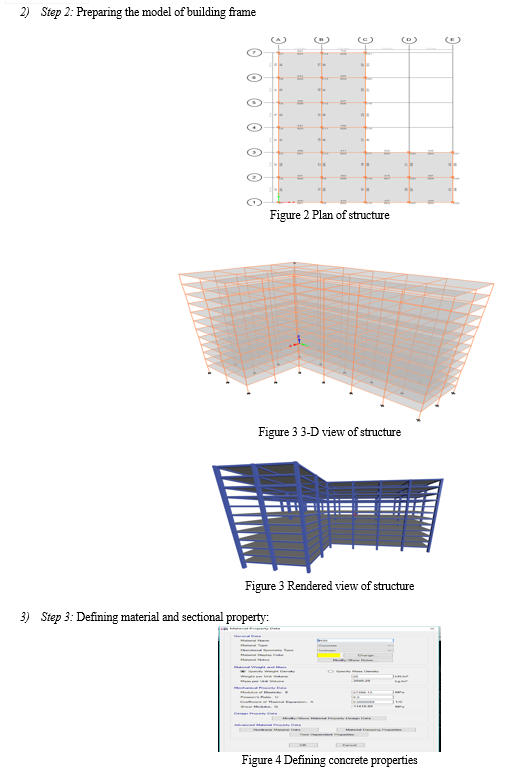
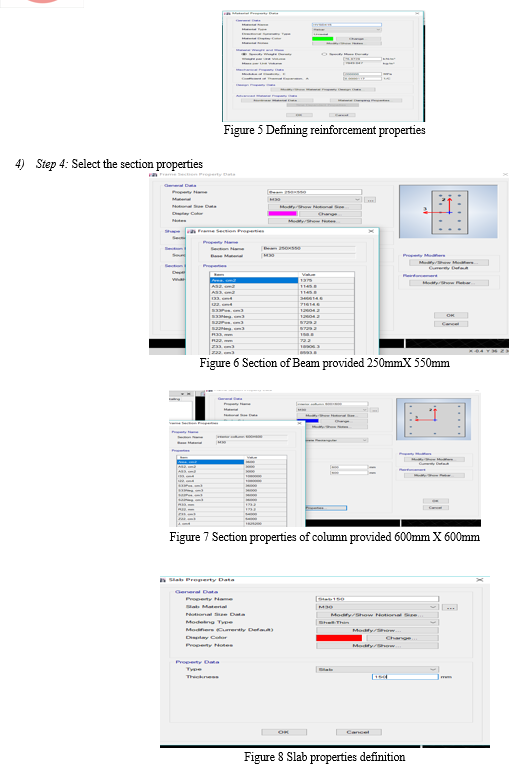



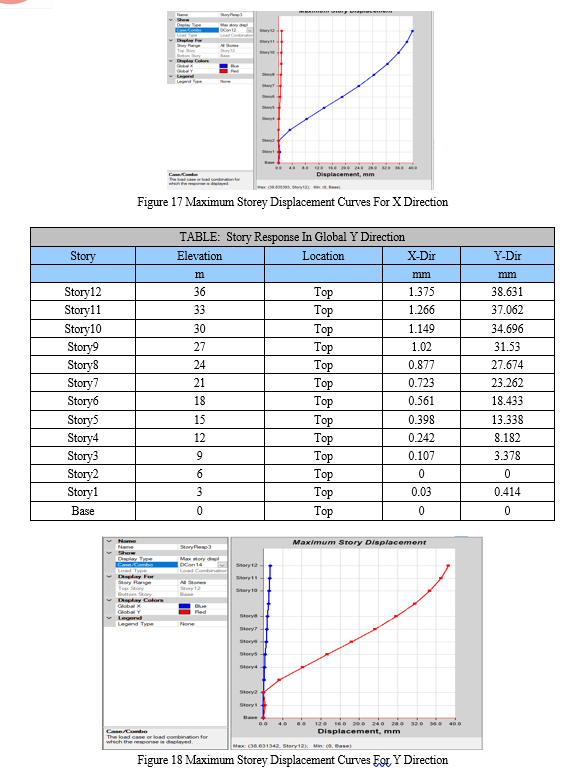

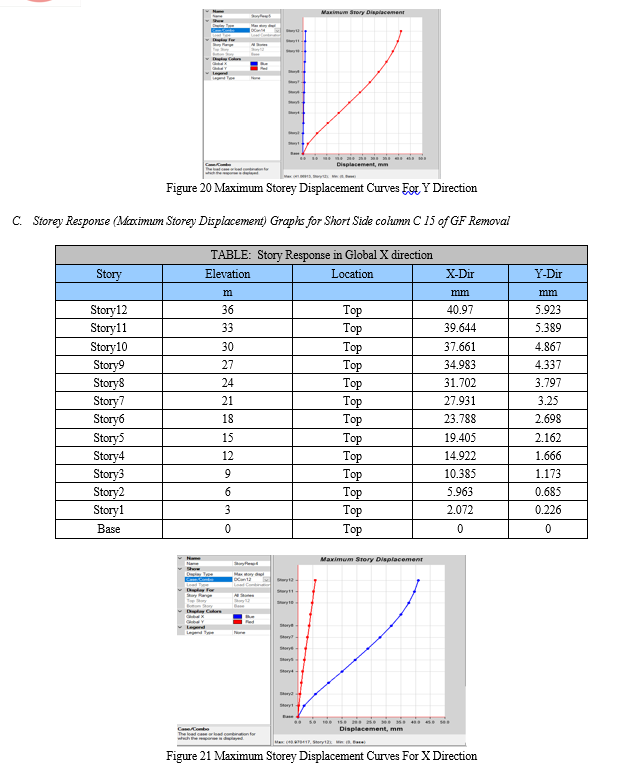
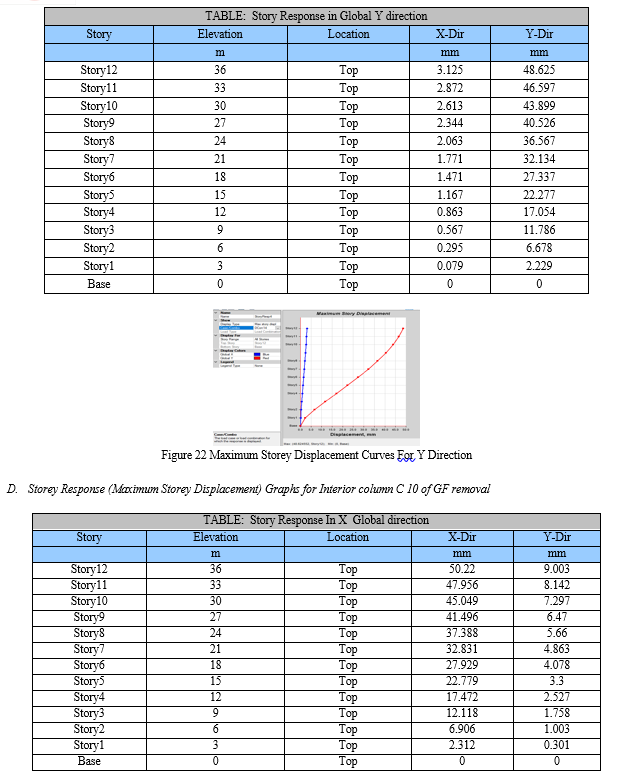

VIII. FUTURE SCOPE
- This study was done by considering irregular L shaped structure, further more shapes can be taken in consideration.
- The use of appropriate bracing system may lead to the stability against progressive collapse in future work.
- A trial can be made by using fibrous concrete instead of normal concrete to increase the flexural strength of members.
- Redesigning the failed elements in flexure and shear is required to prevent the progressive collapse.
It is recommended that the alternative load paths in the form of load bearing bracings and through increase in the size of the exterior columns to minimize the attack of progressive collapse of the building
Conclusion
VIII. CONCLUSION Straight static examination for reformist breakdown obstruction of a 12 story Asymmetric RC building has been accomplished for four section evacuation cases to be specific corner, short edge, long edge and inside according to General Service Administration (GSA) 2013 rules. Segment has been eliminated at ground floor each in turn and Demand Capacity proportions (DCR) for radiates in flexure just as in shear and Compression-bowing Ratio (PMM) values for segments are assessed and introduced as graphs. In light of results and contrasting DCR estimations of various bars and sections with acknowledgment models given in GSA 2013 and American Society of Civil Engineering (ASCE) 41 [10], Following end can be made: 1) Interior column removal case is the most critical (since values of PMM are nearer to limiting value i.e. 2.0) and corner column removal case is least critical. 2) The Demand Capacity ratios (DCR) for all the beams in flexure is very high (maximum 4.5 to minimum 3.5) that is approximately double of the limiting value 2.0 given by GSA 2013. Hence flexure in beam is the critical criteria for ground floor column removal case in progressive collapse process of building. 3) The Demand Capacity ratios (DCR) for all the beams in Shear are just more than 2 (not exceeded by 2.6). Hence Shear in beam is not critical for ground floor column removal case in progressive collapse process of building. 4) For Ground Floor column removal cases beams up to the topmost storey are going to fail for any column removal case since DCR ratio is more than limiting value (2.0) for shear as well as flexure. 5) For most of the column PMM values are less than 2, hence columns are not critical in progressive collapse process of building for all column removal cases. 6) The maximum displacement at all the stories is lowest in corner column removal case and increased by 28.23% if interior column is lost. The displacement at the base of the structure at all nodes for all cases is zero. 7) Redesigning of beams in flexure is required to prevent the progressive collapse of building
References
[1] A.R. Rahai, M. Banazadeh, M.R. SeifyAsghshahr and H. Kazem – “Progressive Collapse Assessment of RC Structures under Instantaneous and Gradual Removal of Columns” - World Conferences on Earthquake Engineering (WCEE), Department of Civil Engineering, Amirkabir University of Technology (Tehran Polytechnic), Iran, 2012. [2] Abhimanyu Abitkar, and Rajendra Joshi – “Progressive Collapse of RC Buildings – Sustainable Analysis Procedures and Their Effects” - Civil Engineering Systems and Sustainable Innovations, College of Engineering Pune, Shivajinagar, Pune, Maharashtra, India, 2011, ISBN: 978-93-83083-78-7. [3] Barun Kumar | A. K. Jha | Rohit Sahu \"Analysis of Parabolic Shell by Different Models Using Software: SAP 2000\" Published in International Journal of Trend in Scientific Research and Development (ijtsrd), ISSN: 2456-6470, Volume-5 | Issue-5 , August 2021, URL: https://www.ijtsrd.com/papers/ijtsrd46337.pdf [4] Choubey and M.D. Goel – “Progressive Collapse Analysis of Rcc Structures” - International Journal of Optimization in Civil Engineering, 2016; 6(2): 287-301. [5] Deeksha Shrotriya Dynamic Study of Parabolic Cylindrical Shell: A Parametric Study\" Published in International Journal of Trend in Scientific Research and Development (ijtsrd), ISSNA:2456-6470,Volume-5|Issue-4,June2021, URL: https://www.ijtsrd.com/papers/ijtsrd43638.pdf [6] Mahmadsabeer and D. GousePeera – “Comparison Design Result of Rcc Building Using Staad and Etabs Software” - International Journal of Innovative Research in Advanced Engineering (IJIRAE), JNTUA, Anantapura Department of civil engineering, August 2015, Volume 2, ISSN: 2349-2163 Issue [7] Marchis, M. Botez and A.M. Ioani – “Vulnerability to Progressive Collapse of Seismically Designed Reinforced Concrete Framed Structures in Romania” - World Conferences on Earthquake Engineering (WCEE), Technical University of Cluj-Napoca, Faculty of Civil Engineering, Cluj-Napoca, Romania, 2012. [8] Miss. Preeti K. Morey and Prof S.R.Satone – “Progressive Collapse Analysis Of Building” - International Journal of Engineering Research and Applications (IJERA), Department of Civil Engineering KDKCE, RTM University, Nagpur-09, Vol. 2, Issue 4, June-July 2012, ISSN: 2248-9622 [9] Mojtaba Hosseini, Nader Fanaie and Amir Mohammad Yousefi1 – “Studying the Vulnerability of Steel Moment Resistant Frames Subjected to Progressive Collapse” - Indian Journal of Science and Technology, Place- Lorestan University, Lorestan, Iran, Vol. No.7, 335–342, March 2014, ISSN (Print): 0974-6846, ISSN (Online): 0974-5645 [10] O. Yagob, K. Galal and N. Naumoski – “Progressive collapse of reinforced concrete structures” - Structural Engineering and Mechanics, Department of Building, Civil and Environmental Engineering, Concordia University, Montréal, Québec, Canada, June 12, 2009, Vol. 32, No. 6 (2009) 771-786. [11] R. Tawakoni, and A. Rashidi Alashti – “Evaluation of progressive collapse potential of multi-story moment resisting steel frame buildings under lateral loading” - Sharif University of Technology, Department of Civil Engineering, Babol University of Technology, P.O. Box 484, Babol, Iran, 24 October 2012. [12] Raghavendra C and Mr. Pradeep A R – “Progressive Collapse Analysis of Reinforced Concrete Framed Structure” - International Journal of Civil and Structural Engineering Research, Department of Civil Engineering, Sri Siddhartha Institute of Technology, Tumkur, India, April 2014 - September 2014, ISSN 2348-7607. [13] Rakshith K G, Radhakrishna – “Progressive Collapse Analysis of Reinforced Concrete Framed Structure” - International Journal of Research in Engineering and Technology, issue in Nov 2013, [14] Yash Jain “Simulation of Progressive Collapse Process of Multi-Storey RC Framed Structure by Linear and Non- Linear Static Analysis Technique Using ETABS Software”, National Institute of Technical Teachers Training and Research, Bhopal, M.P., (2018).
Copyright
Copyright © 2023 Sonu Kumar, Dr. Gunjan Shrivastava. This is an open access article distributed under the Creative Commons Attribution License, which permits unrestricted use, distribution, and reproduction in any medium, provided the original work is properly cited.

Download Paper
Paper Id : IJRASET54863
Publish Date : 2023-07-19
ISSN : 2321-9653
Publisher Name : IJRASET
DOI Link : Click Here
 Submit Paper Online
Submit Paper Online

